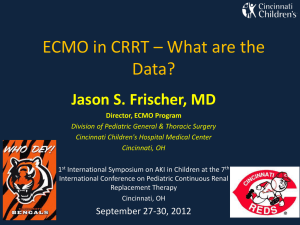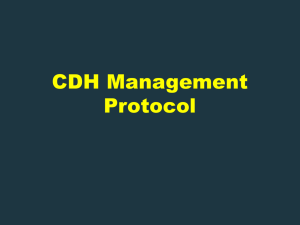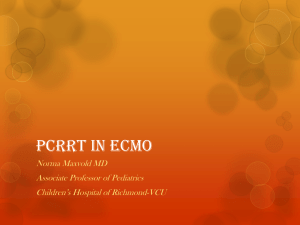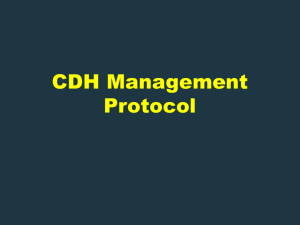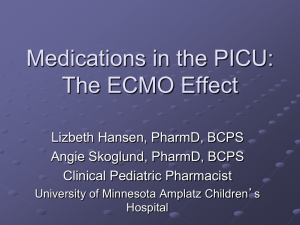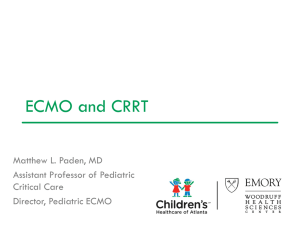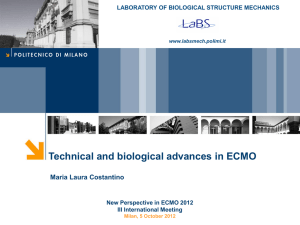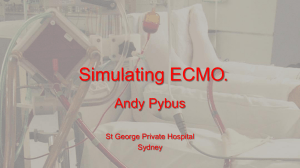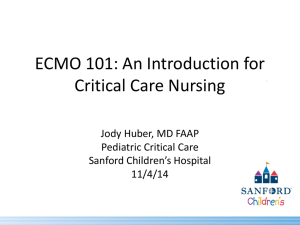Pediatric ECMO and CRRT - Pediatric Continuous Renal
advertisement
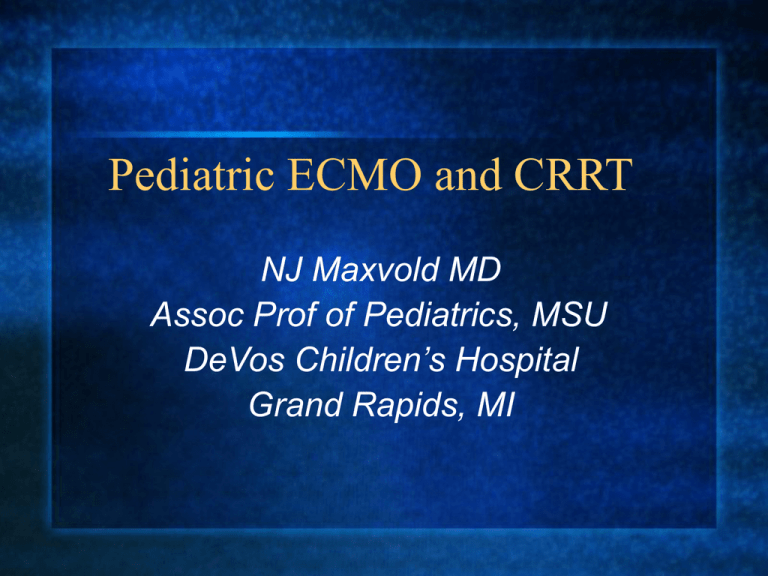
Pediatric ECMO and CRRT NJ Maxvold MD Assoc Prof of Pediatrics, MSU DeVos Children’s Hospital Grand Rapids, MI Pediatric ECMO and CRRT • I would like to thank Dr Picca and Dr Bunchman for this conference • I would like to thank Dr Askenazi for the incorporation of some of his slides into today’s presentation Pediatric ECMO and CRRT Objectives: Review of ECMO in Pediatrics Indications/Limitations/Complications Survival Data • Review of CRRT tandem to ECMO Indications/Limitations/Complications Survival Data ExtraCorporeal Membrane Oxygenation Respiratory Failure vs Cardiac Failure Reticent to Mechanical Ventilatory Equipment (HFOV,HFJV,BiLevel/APRV,NO/Surfactant, etc) Limit Vent-Induce Further Lung Injury Reticent Arrhythmias / CO unresponsive to meds or volume status/ noncandidates for VAD/Post Cardiac Surgery Limit End Organ Ischemia ExtraCorporeal Membrane Oxygenation ECMO Limitations: Patient Size: Cannula/Catheters for Preterm/Small Infants Highly Catabolic-Hypermetabolic States Exceeding Flow Delivery Coagulopathy not correctable by therapeutic supports, or recent Intracranial Bleed Contraindications to system heparinization Irreversible Lung or Cardiac Failure not deemed a Transplant Candidate ExtraCorporeal Membrane Oxygenation • • ECMO Complications: Bleeding: Heparin Anticoagulation Embolic Events: Microemboli / Air emboli from the circuit • • • Catheter Displacement Heparin induced thrombocytopenia ?? End Organ/Renal Effect of Continuous Flow ExtraCorporeal Membrane Oxygenation Russell et al Circulation 2009 End Organ Function Continuous Flow LVAD N= 309 pts, HeartMate II, 6 mo Follow Interval Two Group Analysis: Normal and Above Normal Laboratory Values BUN / Cr 37 / 1.8 AST/ALT 121 / 171 T Bilirubin 2.1 23 / 1.4 mg/dL 36 / 31 IU 0.9 mg/dL Conclusions: Continuous flow maintained or improved end organ function ExtraCorporeal Membrane Oxygenation Ingyinn et al Perfusion 2004 Compared VV to VA Effect on Renal Flow in Lambs 3 Parameters: Systemic Blood Pressure, Renal Blood Flow, Plasma Renin Activity Levels VA and VV Partial Flow (120 mls/kg/min) VA Full Flow (200 mls/kg/min) No difference at partial flow between VV and VA parameters Full VA Flow Significant Increase of Blood Pressure Full VA Flow Flashing/Unclamp of ECMO Bridge BP Renal Flow Conclusion: Potential cause of the Hypertension that is seen in some newborns after VA ECMO ExtraCorporeal Membrane Oxygenation Mussaro et al Pediatr Crit Care Med 2009 Evaluated Bloodless Bridge on VA ECMO (No Flashing/Unclamping) Retrospective comparison to the Earlier Bridge ECMO Setup Parameters: BUN, Cr, Fld Balance, Urine Ouput, Average and max SBP, mean BP No Difference in BUN, Cr, Fld Balance, Urine Output Lower % of HTN (Mean BP> 60), Lower SBP on Days 2, 3 Conclusion: Less HTN with the new bridge design that did not require flashing therefore improved maintenance of Renal flow ExtraCorporeal Membrane Oxygenation Basic ECMO Design / Setup: Venovenous Design: Outflow and Inflow catheters in Venous System VenoArterial Design / Setup: Outflow from Venous (R Atrium), Inflow Arterial (Aortic Arch) VA vs. VVDL Cannulation Typical VVDL catheter placement ECMO Centrifugal Pump Setup Centrifugal circuit design ExtraCorporeal Membrane Oxygenation ECMO Neonatal/Pediatric Survival Data: ELSO Registry 1998-2008 Neonates ( </= 30 days old) N= 8958 Survival: 5776 (72.6%) NonSurvival: 2182 (27.4%) ExtraCorporeal Membrane Oxygenation ECMO and PCRRT Indications for CRRT tandem with ECMO Systems Set Up Design Publications reviewing PCRRT and ECMO Survival and Longterm Renal Outcomes PCRRT and ECMO CRRT/ECMO Indications ?? Fluid Overload > 10% ( Michael et al Pediatr Nephrol 2004) pRIFLECr maxF (Akcan-Arikan et al Kidney Int 2007) [Definition : eCCl by 75% or <35m/min/1.73m2] • Nutritional Limitation ( Due to Inadequate Solute/ Fluid Clearance) CRRT on ECMO “Homemade” system connected to the ECMO circuit IV infusion pumps used to control ultrafiltrate (if replacement desired) IV infusion pump to add replacement fluids Several sites to hook into circuit each with drawbacks ( shunting, bubble trap, flows) IV pumps are not engineered to maintain accuracy when flow/pressure above the pump is variable. ECMO/CRRT Arrangement: Homemade System ECMO/CRRT Arrangement: RRT System ECMO and CRRT Hemofilter (Homemade) Ultrafiltration IV pump control controlled Metabolic Control NO CRRT CRRT machine controlled YES ECMO Flow Blood Shunt NO systemic -decrease ECMO changes flow or decreased PaO2 to patient Anti-coagulation Heparin Heparin CRRT/ECMO in Tandem CRRT/ECMO Centrifugal Pump Santiago et al Kidney Int 2009 N= 6 children on VA ECMO Inlet line after the Centrifugal Pump Outlet/return line before the Oxygenator Mean Filter Life = 138 hours CRRT/ECMO in Tandem CRRT/ECMO Outcomes Meyer RJ, et al Pediatr Crit Care Med 2001 • 15/ 35 ( 42.9 %) neonatal and pediatric survived 14/15 (93%) RENAL RECOVERY 1/15 (7%) – Wegener’s CRRT/ECMO in Cardiac Newborns Shah SA et al. ASAIO J 2005 41/ 84 (48.9%) post-operative congenital heart disease patients with AKI CVVH NOT associated with : Ability to wean off ECMO Survival to discharge Kolovos et al. Ann Thorac Surg 2003 26 / 74 (35%) post-operative congenital heart disease patients Hemofiltration = 5.01 X increased risk of death CRRT/ECMO – Noncardiac Children Hoover et al. Intensive Care Med (2008) Case-control study Cases 26/86 - received CVVH for >24 hours Controls – no CVVH Significant differences in fluid balance Significant treatment differences No difference in survival or vent days during or after ECMO ECMO/CRRT Askenazi et al Abstract CRRT 2009 ELSO Registry Data,1998-2008 8958 patients age ≤ 30 days Asked the Question: Hypothesis: After controlling for demographic, complications, severity of illness, interventions, does AKI / RRT predict mortality in non-cardiac neonates who require ECLS? Extracorporeal Life Support Organization (ELSO) Registry AKI Categorically defined Complication code of SCr ≥ 1.5 mg/dl or ICD-9 code of Acute renal failure Dialysis CPT codes used Survival Demographics, Complications, CoMorbidities and Interventions Askenazi et al. Abstract CRRT 2009 ELSO Registry - Neonates 18% 5% 3% 74% Neither AKI Both RRT Askenazi et al. Abstract CRRT 2009 ELSO Registry - Neonates Survival by AKI/RRT class 5000 4000 3000 2000 1000 0 Neither AKI Non-Survivors Both RRT Survivors Askenazi et al. Abstract CRRT 2009 ExtraCorporeal Membrane Oxygenation ELSO Pediatric Registry 1998-2008 N = 2514 Survival = 1410 (56%) ELSO Accumulative (1985-2008) N = 4065 Survival = 2247 (55.3%) Ped Pts Receiving Dialysis (1985-2008) N = 1616 (39%) Survival = 606 (37.5%) • ELSO 1985-2008 Cardiac Runs Age Total Runs 0-30 days N=3824 N=1430 (37.4%) N=2428 N=1058 (43.6%) N=2034 N=975 (47.9%) N=1113 N=388 ((34.9%) 1-12 months 1-16 years >16 years Survival Dialysis Survival N=1595 (41.7%) N=926 (38%) N=783 (38.5%) N=533 (47.9%) N=354 (22.2%) N=244 (26.3%) N=273 (34.9%) N=118 (22.1%) CRRT/ECMO Summary ECMO&CRRT Can be Safely done in a variety of setups No additional regional Anti-coagulation is needed since the patient and the entire circuit is already heparinized for ECMO Circuit prime for the CRRT can usually be saline Due to the relative size of the CRRT circuit in ratio to the larger ECMO circuit • When starting Ultrafiltation careful monitoring of fluid goals over a time period will prevent Hct and viscosity changes that are unwanted • CRRT Support on ECMO Effect on Mortality is yet to be more clearly defined as to timing of Initiation of both supports and Subsequent Outcomes. ECMO Circuit Aortic Arch Right Atrium Blood Return Heat Exchanger Blood Drainage Bridge Servo-regulation Pump Heparin and Fluids Membrane Oxygenator

